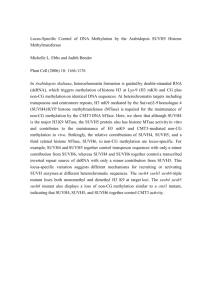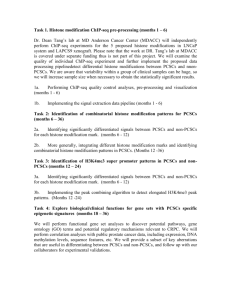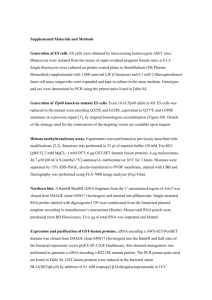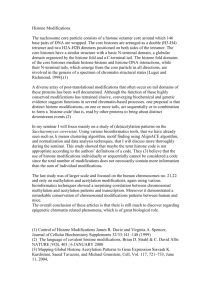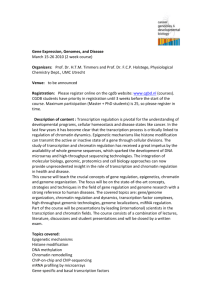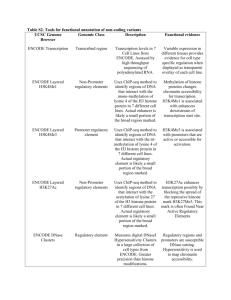Berger layout final.indd
advertisement
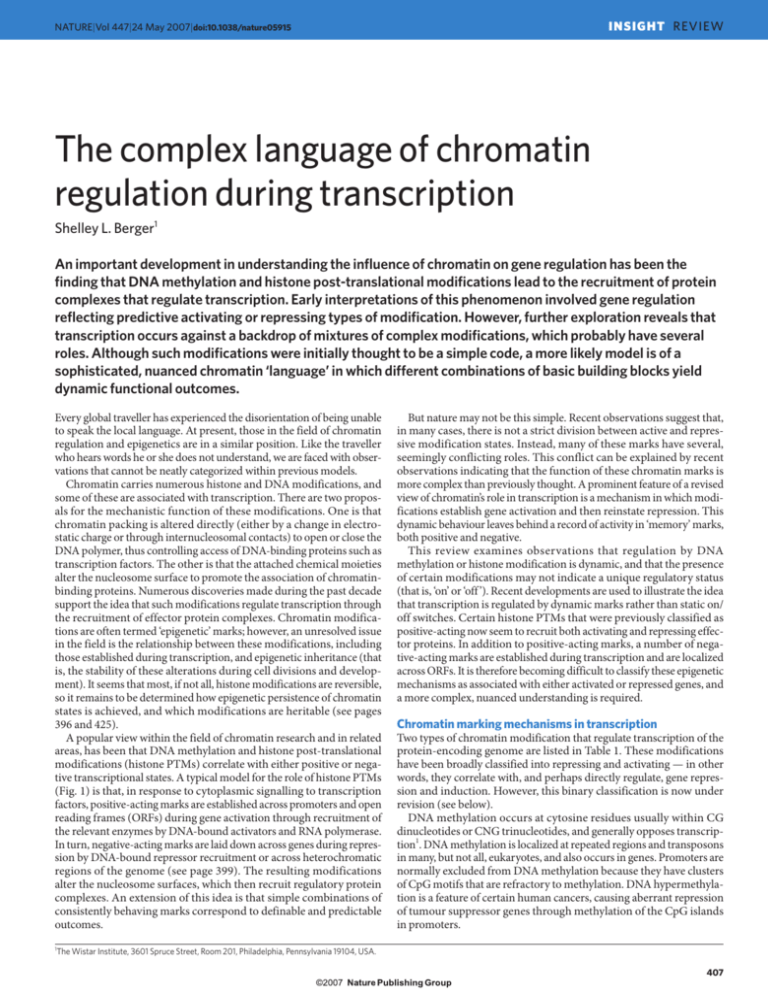
INSIGHT REVIEW NATURE|Vol 447|24 May 2007|doi:10.1038/nature05915 The complex language of chromatin regulation during transcription Shelley L. Berger1 An important development in understanding the influence of chromatin on gene regulation has been the finding that DNA methylation and histone post-translational modifications lead to the recruitment of protein complexes that regulate transcription. Early interpretations of this phenomenon involved gene regulation reflecting predictive activating or repressing types of modification. However, further exploration reveals that transcription occurs against a backdrop of mixtures of complex modifications, which probably have several roles. Although such modifications were initially thought to be a simple code, a more likely model is of a sophisticated, nuanced chromatin ‘language’ in which different combinations of basic building blocks yield dynamic functional outcomes. Every global traveller has experienced the disorientation of being unable to speak the local language. At present, those in the field of chromatin regulation and epigenetics are in a similar position. Like the traveller who hears words he or she does not understand, we are faced with observations that cannot be neatly categorized within previous models. Chromatin carries numerous histone and DNA modifications, and some of these are associated with transcription. There are two proposals for the mechanistic function of these modifications. One is that chromatin packing is altered directly (either by a change in electrostatic charge or through internucleosomal contacts) to open or close the DNA polymer, thus controlling access of DNA-binding proteins such as transcription factors. The other is that the attached chemical moieties alter the nucleosome surface to promote the association of chromatinbinding proteins. Numerous discoveries made during the past decade support the idea that such modifications regulate transcription through the recruitment of effector protein complexes. Chromatin modifications are often termed ‘epigenetic’ marks; however, an unresolved issue in the field is the relationship between these modifications, including those established during transcription, and epigenetic inheritance (that is, the stability of these alterations during cell divisions and development). It seems that most, if not all, histone modifications are reversible, so it remains to be determined how epigenetic persistence of chromatin states is achieved, and which modifications are heritable (see pages 396 and 425). A popular view within the field of chromatin research and in related areas, has been that DNA methylation and histone post-translational modifications (histone PTMs) correlate with either positive or negative transcriptional states. A typical model for the role of histone PTMs (Fig. 1) is that, in response to cytoplasmic signalling to transcription factors, positive-acting marks are established across promoters and open reading frames (ORFs) during gene activation through recruitment of the relevant enzymes by DNA-bound activators and RNA polymerase. In turn, negative-acting marks are laid down across genes during repression by DNA-bound repressor recruitment or across heterochromatic regions of the genome (see page 399). The resulting modifications alter the nucleosome surfaces, which then recruit regulatory protein complexes. An extension of this idea is that simple combinations of consistently behaving marks correspond to definable and predictable outcomes. But nature may not be this simple. Recent observations suggest that, in many cases, there is not a strict division between active and repressive modification states. Instead, many of these marks have several, seemingly conflicting roles. This conflict can be explained by recent observations indicating that the function of these chromatin marks is more complex than previously thought. A prominent feature of a revised view of chromatin’s role in transcription is a mechanism in which modifications establish gene activation and then reinstate repression. This dynamic behaviour leaves behind a record of activity in ‘memory’ marks, both positive and negative. This review examines observations that regulation by DNA methylation or histone modification is dynamic, and that the presence of certain modifications may not indicate a unique regulatory status (that is, ‘on’ or ‘off ’). Recent developments are used to illustrate the idea that transcription is regulated by dynamic marks rather than static on/ off switches. Certain histone PTMs that were previously classified as positive-acting now seem to recruit both activating and repressing effector proteins. In addition to positive-acting marks, a number of negative-acting marks are established during transcription and are localized across ORFs. It is therefore becoming difficult to classify these epigenetic mechanisms as associated with either activated or repressed genes, and a more complex, nuanced understanding is required. Chromatin marking mechanisms in transcription Two types of chromatin modification that regulate transcription of the protein-encoding genome are listed in Table 1. These modifications have been broadly classified into repressing and activating — in other words, they correlate with, and perhaps directly regulate, gene repression and induction. However, this binary classification is now under revision (see below). DNA methylation occurs at cytosine residues usually within CG dinucleotides or CNG trinucleotides, and generally opposes transcription1. DNA methylation is localized at repeated regions and transposons in many, but not all, eukaryotes, and also occurs in genes. Promoters are normally excluded from DNA methylation because they have clusters of CpG motifs that are refractory to methylation. DNA hypermethylation is a feature of certain human cancers, causing aberrant repression of tumour suppressor genes through methylation of the CpG islands in promoters. 1 The Wistar Institute, 3601 Spruce Street, Room 201, Philadelphia, Pennsylvania 19104, USA. 407 INSIGHT REVIEW NATURE|Vol 447|24 May 2007 a OFF HDAC ac REP H3/H4 ORF URS b ON COMPASS DOT1 Set2 HAT H3/H4ac K4me ACT K36me K79me ORF ORF UAS S5ph CTD POL POL S2ph CTD Figure 1 | Model for activation and repression. a, In the off state, the DNAbound repressor (REP) at the upstream repressor site (URS) recruits negative modifiers, such as histone deacetylase (HDAC), which remove acetyl (ac) groups from histones. b, In the on state, DNA-bound activator (ACT) at the upstream activator site (UAS) recruits positive modifiers, such as histone acetylases (HAT), at the promoter, while DNA-bound RNA polymerase (POL) recruits histone methylases at the ORF. Early during elongation, the C-terminal domain (CTD) polymerase repeat is phosphorylated at serine 5 (S5ph), leading to recruitment of the COMPASS complex (Set1, part of the COMPASS complex, methylates H3K4) and DOT1 (which methylates H3K79). Later in elongation the CTD repeat is phosphorylated at serine 2 (S2ph), leading to recruitment of Set2 (which methylates H3K36). There are various histone PTMs, including acetylation, phosphorylation, methylation, ubiquitylation and SUMOylation. These modifications decorate the canonical histones (H2A, H2B, H3 and H4), as well as variant histones (such as H3.1, H3.3 and HTZ.1). Most modifications localize to the amino- and carboxy-terminal histone tails, and a few localize to the histone globular domains. Because this review focuses on emerging trends relating to histone PTMs, only certain modification sites will be discussed to illustrate general concepts; there are recent reviews that provide exhaustive descriptions of the sites and modification enzymes2. Lysine is a key substrate residue in histone biochemistry, because it undergoes many exclusive modifications, including acetylation, methylation, ubiquitylation and SUMOylation. Acetylation and methylation involve small chemical groups, whereas ubiquitylation and SUMOylation add large moieties, two-thirds the size of the histone proteins themselves — which, owing to their bulk, may lead to more profound changes in chromatin structure. Another degree of complexity is that methylation can occur several times (mono-, di- or trimethylation) on one lysine side chain, and each level of modification can have different biological outcomes. Some of the functional outcomes of these modifications are clear. For example, there is abundant evidence that acetylation is activating, whereas SUMOylation seems to be repressing, and these two types of modification may mutually interfere. By contrast, methylation and ubiquitylation have variable effects, depending on the precise residues and contexts. For example, trimethylation of lysine 4 in histone H3 (H3K4me3) occurs at the 5ʹ ends of ORFs as genes become induced, whereas H3K9me3 occurs in compact pericentromeric heterochromatin, which is transcriptionally inert. Two ubiquitylation sites in the C termini of H2B and H2A correlate with active and repressed transcription, respectively. 408 In H3 and H4, arginine residues can also be mono- or dimethylated, and in the latter case the methyl groups can be placed symmetrically or asymmetrically on the side chain. Arginine methylation seems to be strictly activating to transcription. Serine/threonine phosphorylation is also involved in transcription. H3 phosphorylation (ph) is the most wellcharacterized, and H3S10ph correlates with both activated transcription and mitotic chromosome condensation — thus, with both opening and closing of chromatin — which illustrates the importance of genomic context (an idea that is developed further below). It should be noted that unbiased mass spectrometry carried out in many laboratories has led to the conclusion that the most prevalent histone PTMs in the core histones are now known. However, there may be other classes of histone PTM. For example, proline isomerization is a non-covalent alteration that occurs in H3, interconverting active and inactive conformations of the N-terminal tail for transcriptional regulation3. All histone PTMs are removable. Histone deacetylases (HDACs) remove acetyl groups and Ser/Thr phosphatases remove phosphate groups. Ubiquitin proteases remove mono-ubiquitin from H2B. Arginine methylation is altered by deiminases, which convert the side chain to citrulline. Two classes of lysine demethylase have recently been identified: the LSD1/BHC110 class (which removes H3K4me1 and me2)4,5 and the jumonji class (which removes H3K4me2 and me3, H3K9me2 and me3, and H3K36me2 and me3)6–12. This finding put an end to heated debate about the reversibility of histone lysine methylation and whether it is the only ‘true’ epigenetic histone PTM. As mentioned above, the functional consequences of histone PTMs can be direct, causing structural changes to chromatin, or indirect, acting through the recruitment of effector proteins. The structure of the H4 N-terminal tail is critical to contacts between nucleosomes. For example, acetylation of H4K16 in a naive chromatin array assembled from bacterial recombinant histones results in relaxation of the array13. In addition to the idea that histone PTMs directly alter nucleosome fibre structure is an expanding body of evidence that histone PTMs serve as binding surfaces for the association of effector proteins. The initial finding was for acetyl lysine, which has been shown to associate with bromodomains. In this case, acetylated H3 stabilizes binding of the histone acetyltransferase GCN5 through its bromodomain14. Lysine methylation provides an important switch for binding of representatives of the ‘royal family’ of domains, including chromodomains and tudordomains. The key observation was methyl H3K9 association with the Table 1 | Chromatin modifications Mark* Transcriptionally relevant sites† Transcriptional role‡ CpG islands Repression Acetylated lysine (Kac) H3 (9, 14, 18, 56), H4 (5, 8, 13, 16), H2A, H2B Activation Phosphorylated serine/ threonine (S/Tph) H3 (3, 10, 28), H2A, H2B Activation Methylated arginine (Rme) H3 (17, 23), H4 (3) Activation Methylated lysine (Kme) H3 (4, 36, 79) H3 (9, 27), H4 (20) Activation Repression Ubiquitylated lysine (Kub) H2B (123§/120¶) H2A (119¶) Activation Repression Sumoylated lysine (Ksu) H2B (6/7), H2A (126) Repression Isomerized proline (Pisom) H3 (30–38) Activation/ repression DNA methylation Methylated cytosine (meC) Histone PTMs *The modification on either DNA or a histone. †Well-characterized sites with regard to genomic location for DNA methylation or residues within histones for PTMs. ‡Whether the epigenetic mark is associated with activation or repression. §Yeast (Saccharomyces cerevisiae). ¶Mammals. INSIGHT REVIEW NATURE|Vol 447|24 May 2007 chromodomain of heterochromatin-like protein 1 (HP1) to promote its binding to heterochromatin15,16. There are now other examples consistent with these initial observations. So, simple early models suggested that certain single or combinatorial marks underlie either an active or inactive chromatin state with respect to transcription (Fig. 1). However, recent discoveries show that the functional epigenetic landscape is much more complex than previously thought. H3K4 methylation recruits multiple effectors The functional outcome of H3K4 methylation provides an example of the recent revision in models describing the role of modifications. As described above, H3K4 methylation has been thought to be a positiveacting histone PTM that increases as genes become active; H3K4me3 specifically localizes to the 5ʹ ends of ORFs. The role of this histone PTM in recruiting downstream effectors is currently under intensive investigation and, surprisingly, it has been found that a single mark recruits numerous proteins whose regulatory functions are not only activating but also repressing. The location and timing of H3K4 methylation during gene activation led to a prediction that complexes recruited by this histone PTM are involved in transcriptional activation. Indeed, as expected, several complexes that are reported to bind H3K4me participate in gene induction (Fig. 2). The yeast SAGA complex, which contains the H3 acetyltransferase Gcn5, associates with the chromodomain protein and chromatin remodeller Chd1 (ref. 17). Chd1 binds to H3K4me, assisting in the recruitment of SAGA and leading to enhanced acetylation. CHD1 may be more important as an H3K4me binder in mammalian systems than in yeast18. These observations indicate that chromodomain proteins bind to methylated H3K4 as well as to methylated H3K9. Other domains, unrelated to chromodomains, also bind to methylated H3K4. The MLL complex (also known as the Set1 K4 methylation complex) contains a WD40-repeat protein known as WDR5, which binds to H3K4me2 to contribute the trimethyl mark19, although it is currently unclear whether WDR5 binds specifically to methylated H3K4 (refs 18, 20, 21). Another H3K4me3-interacting domain frequently found in chromatin-interacting proteins, the plant homeodomain (PHD) finger, binds preferentially to H3K4me3 to recruit positive-acting enzymatic complexes. H3K4me3 stabilizes binding of the ATP-dependent nucleosome remodelling factor (NURF) to target genes, and bromodomain PHD transcription factor (BPTF) is required for binding22. This pathway targets the homeodomain gene locus for activation, and the developmental effects of lowering BPTF levels are phenotypically similar to those of reducing levels of the MLL H3K4me3 enzyme, thus linking the enzyme and its binding effector protein in vivo. Similarly, the PHDcontaining Yng1 protein in the NuA3 (nucleosomal acetyltransferase of histone H3) complex, containing the Sas3 acetyltransferase, binds preferentially to methylated H3K4 (ref. 23). Because Gcn5 and Sas3 are major H3K14 acetylation enzymes in yeast24, it is striking that H3K4me targets both of their complexes, SAGA and NuA3 respectively, to chromatin. All of these interactions support the idea that methylated K4, a histone PTM that increases across ORFs during gene induction, serves to recruit positive-acting effector complexes. It is therefore surprising that other complexes binding to the H3K4me3 modification are associated with transcriptional repression and not gene activation (Fig. 2). In response to DNA damage, the Sin3–Hdac1 deacetylation complex binds to H3K4me3 through the PHD domain of the Ing2 (inhibitor of growth family member 2) protein (related to Yng1 in NuA3) contained in the complex25. This stimulates Hdac1 activity in vitro, and stabilizes the recruitment of the Sin3–Hdac1 complex to target genes. This, in turn, leads to active repression of genes involved in proliferation to modulate cellular response to genotoxic damage. Another example is the JMJD2A protein, a lysine demethylase that targets H3K9me3 and H3K36me3, and is present in co-repressor complexes N-CoR (nuclear hormone co-repressor complex) and retinoblastoma. Through its tandem tudor domains, JMJD2A associates with H3K4me3 and H4K20me3 (ref. 26). Thus, it seems that H3K4me3 (and possibly H4K20me3) recruits JMJD2A to demethylate H3K9 and H3K36. Because JMJD2A associates with corepressor complexes, this recruitment presumably leads to gene repression. These seemingly contradictory findings raise a number of questions: in particular, how can the binding of so many complexes to one histone PTM be explained? Several distinct classes of binding module recognize this mark, including the royal family domains (including chromodomains) and the PHD domains, and the different domains may bind in structurally distinct ways. The binding of single and combinations of domains to methylated lysine substrates is a complex process (see ref. 26 for an example). However, the more pressing biological question is why a single positive-acting histone PTM recruits effectors that are either activating or repressing. It may be that there is an intricate ‘dance’ of associations, with these changing places over time. The positiveacting complexes (such as SAGA, MLL and NuA3) may be recruited during initiation or elongation, followed by recruitment of negative-acting complexes (JMJ2D and Sin3-Hdac) during attenuation of transcription. In this case, the entire chromatin context of H3K4me3 (that is, other histone PTMs changing around it during the transcription process) would dictate the overall outcome, because other binding domains in individual complexes interact with neighbouring histone PTMs. Because both negative- and positive-acting effector complexes bind to the same histone PTM (in this case, H3K4me), these findings also strongly underscore the likely importance of DNA-bound transcription factors (repressors and activators, respectively) to discriminate during initial recruitment. Negative marks suppress cryptic RNA initiation In addition to H3K4 methylation across the 5ʹ end of genes, there are numerous other histone PTMs that occur across promoters and transcribed regions. Nucleosomes within genes constitute an obstacle to both appropriate transcription and inappropriate initiation. Thus, transcription is accompanied by disruption of histone–DNA contacts as RNA polymerase moves along, followed by reformation of nucleosomes in the wake of the enzyme. New findings show that the intricate timing of this wave is regulated by both positive- and negative-acting histone PTMs. Positive-acting histone PTMs occur across transcribed regions and have been mechanistically linked to particular stages of transcription a NURF COMPASS NuA3 3 2 3 Chd1 2/3 Initiation/ elongation H3K4me ORF b Sin3– Hdac1 JMJD2A Attenuation/ repression H3K4me3 × ORF Figure 2 | H3K4me-binding proteins. a, H3K4me recruitment of activating effector proteins or complexes (Chd1, COMPASS, NURF and NuA3; numbers indicate whether they bind to H3K4me2 and/or H3K4me3) that destabilize nucleosomes during transcriptional initiation and elongation. b, H3K4me3 recruitment of repressing effector proteins or complexes (Sin3–Hdac1 and JMJD2A) that stabilize nucleosomes during transcription attenuation or repression. 409 INSIGHT REVIEW NATURE|Vol 447|24 May 2007 (Fig. 3a, b). A widely accepted model is that a series of interlocking histone PTMs occur during initiation, early elongation and mature elongation, and that these events are each required for full transcriptional activation. The placement of histone PTMs is also coupled to both nucleosome clearance in the promoter and exchange of histone variants in the promoter and the ORFs, two chromatin remodelling events that occur during transcription27–30. The histone PTMs involve phosphorylation and acetylation of H3 through activator-mediated recruitment of kinase and acetylase complexes, followed by a complex series of ubiquitylation and methylation marks dependent on phosphorylation of RNA polymerase II. H2B becomes ubiquitylated on K123, which is, in turn, linked to methylation of H3 on K4 and K79. H2BK123 then becomes de-ubiquitylated, allowing H3K36 to be methylated31. However, recent evidence indicates that ORF ‘marking’ is more complicated than even this elaborate series of histone PTMs. Several years ago, it was shown that transcriptional initiation can occur inside ORFs through ‘cryptic’ TATA boxes, and that internal initiation is detrimental to normal transcription32. Mutations in elongation factors that travel with RNA polymerase II cause a rise in this cryptic initiation, and increased cryptic initiation can be suppressed by mutations in RNA polymerase II. An abnormal chromatin structure is involved, manifested in altered nuclease digestion patterns correlating with the aberrant internal initiation. Furthermore, the elongation factors that suppress spurious internal start sites also facilitate nucleosome alteration during transcription32,33. Mechanisms that regulate cryptic initiation were recently extended to include histone PTMs and their effector proteins. Histone acetylation a Initiation/early elongation ORF TATA H3/H4ac H3/H4ac H2BK123ub H3K4me/K79me b Later elongation/attenuation ORF H3/H4dac H2BK123dub H3K36me H3/H4dac DNAme c Internal initiation ORF H3/H4ac H2BK123ub H3K4me/K79me Figure 3 | Model for positive and negative chromatin marks in ORFs. a, Histone PTMs that occur during early transcription include H3/H4 acetylation, H2BK123 ubiquitylation and H3K4/K79 methylation. b, Histone PTMs that occur during late transcription include H3/H4 deacetylation (dac), H2B de-ubiquitylation (dub), H3K36 methylation and DNA methylation. Dashed arrow indicates waning transcription due to attenuation. c, Persistent inappropriate positive histone PTMs (H3/H4 acetylation, H2BK123 ubiquitylation and H3K4/K79 methylation) at the ORF cause internal initiation downstream of a cryptic TATA sequence. 410 Table 2 | Context-dependence of histone methylation Methylated histone Location* Transcriptional activity† Transcriptional status‡ H3K4me3, H3K9me3 ORFs Inducible Dynamic H3K9me3, H4K20me3 Pericentromeric heterochromatin Constitutive Silenced H3K4me3, H3K27me3 Embryonic stem cell bivalent domains Constitutive Poised for transcription *Where each dual modification is typically found in the genome. †Whether the dual histone PTM is detected during transcription (inducible) or is present continuously (constitutive). ‡Whether the location of the dual histone PTM marks an inducible gene (dynamic), a silenced region, or a region that is currently transcriptionally repressed but can be activated (poised). is involved in destabilizing or removing nuclesosomes in transcribed regions34. One mechanism to prevent cryptic initiation is the reformation of positioned nucleosomes after the passage of RNA polymerase II, as mentioned above. Indeed, some of the histone PTMs that were previously thought to have a positive mechanistic effect on chromatin during transcription — because of their presence within ORFs and their increase during gene induction — seem instead to close the chromatin over the ORF (Fig. 3c). Thus, one role of H3K36me, which is linked to the passage of RNA polymerase II across the ORF (Fig. 1), is to recruit a deacetylase complex35–37. This recruitment involves a chromodomain present in the deacetylase complex, which binds to H3K36me, thereby promoting association of the histone deacetylase and removal of the nucleosome-destablizing acetyl groups. This H3K36-methylation linked deacetylation is required to suppress internal initiation. These observations raise more questions. For example, are negative-acting epigenetic mechanisms generally required to reform nucleosomes over transcribed regions after transcription? Tantalizing clues indicate that this may be the case. First, methylated H3K9 is a well-known negative-acting histone PTM, serving to recruit HP1 through its chromodomain to lead to the formation of pericentromeric heterochromatin (see page 399). Surprisingly, H3K9me3 and HP1 have also been seen to occur within ORFs, and actually increase as transcription of genes is induced38,39 — a result strikingly similar to the induction of methylated H3K36. This suggests that methylated H3K9 may have a similar role to methylated H3K36 in transcription — that is, to reform positioned nuclesomes over the transcribed region after the transit of RNA polymerase. Second, as described above, DNA methylation commonly occurs in promoters and genes to repress transcription. However, completion of genome-wide microarray analysis of DNA methylation in Arabidopsis indicates that, in addition to its expected distribution in silenced heterochromatin, DNA methylation is also common across ORFs40,41. Even more unanticipated is the presence of DNA methylation in the ORFs of many actively transcribed genes. So, like the histone modifications of H3K36 and H3K9 methylation, DNA methylation may help to control internal initation by reforming nucleosome structure across transcribed regions after transcription. There is evidence of even greater complexity during the course of transcriptional elongation. As mentioned above, the transit of RNA polymerase across the transcription unit is preceded by a leading wave of initial positive histone PTMs to open the chromatin by transient displacement of nucleosomes33. These initial histone PTMs might later be removed, but may leave behind a ‘trail’ for further rounds of transcription. There are two distinct stages of transcription elongation that can be distinguished by different degrees of H3 methylation42. Staged evolution of histone PTMs in the ORF during the course of transcription may explain perplexing older observations in yeast that the Hos2 deacetylase is present within ORFs, its levels actually rising with gene activation, and is required for full gene activation43. Similarly, both H2B ubiquitylation and de-ubiquitylation is required for optimal transcription of certain genes44. Both the deacetylase and de-ubiquitylase may be required to remove positive-acting histone PTMs across the ORF, and set the stage for re-closure. A related possibility is that the negative-acting marks with respect to chromatin may function to set up the ORF for subsequent INSIGHT REVIEW NATURE|Vol 447|24 May 2007 rounds of transcription — thus, they may not only function to close the chromatin structure, but might also have a positive effect on overall transcription through stabilizing the chromatin within ORFs. So, in the face of such contradictions and subtle biological roles it seems impossible to simply classify most marks as activating or repressing . Future challenges in deciphering histone PTM function From these examples it is clear that chromatin marks cannot be easily interpreted — several seem to have both a positive and a negative connotation. Thus a useful analogy may be that the modifications constitute a nuanced language, in which individual marks (the ‘words’) become meaningful only once they are assembled and viewed within their unit array, such as a transcription unit (a ‘sentence’). To put it simply, the genomic and regulatory context must be considered for the biological meaning to be understood. Because marks can indicate dynamic activity, memory of activity or poising for future activity, it is not possible to simply scan large chromosomal territories of the genome to understand a particular activity. Rather, it is necessary to observe the combination of marks and their genomic context using other signposts to interpret past history and current or future activity. H3K4me3 and H3K9me3 are instructive examples: once thought to define activated or repressed chromatin, respectively, these marks can have vastly different messages depending on the other histone PTMs present (Table 2), and may, in fact, contradict previous interpretation (Table 1). As described above, the combination of inducible H3K4me3 and H3K9me3, detected within ORFs, indicates the current stage of dynamic transcriptional activity. By contrast, the combination of constitutive H3K9me3 and H4K20me3 seen at pericentromeric heterochromatin45 indicates closed chromatin and repression. Furthermore, in embryonic stem cells there are unusual chromatin domains that include both H3K4me3 and H3K27me3 — again, a combination of what were thought to be positive and negative marks. These ‘bivalent domains’ correlate with locations of genes for transcription factors that regulate development46. It is thought that such genes are transcriptionally silenced but poised for activation during differentation. In neurons that differentiate from these stem cells, H3K4me3 remains constant (and H3K27me3 is lost) at genes that become active, whereas H3K27 persists (and H3K4me3 is removed) at genes that remain inactive. Thus, epigenetic status of the original stem cells can be confounding with respect to understanding transcriptional activity. To understand this bewildering complexity, several approaches will be crucial. Elucidating the specific roles of individual histone PTMs will require multiple approaches, including temporal studies in vivo on synchronized populations. Chromatin immunoprecipitation analysis should reveal the order in which complexes are recruited, the concurrent chromatin modifications present, and their resulting marks at both gene and genome-wide scales during transitions from repression to activation, to attenuation, and back to repression. Interdependence of dynamic changes in the modifications must be examined by use of targeted disruption of enzymes and the modifications themselves (in the case of histone PTMs) in yeast models. The mono-, di- or trimethylation status may dictate temporal sequence of recruitment, requiring targeted disruption or knockdown of specific enzymes that set specific states. In cases in which enzymes catalyse all three methylation states (for example, Set1 within the COMPASS or MLL complexes catalysing H3K4me1, 2 and 3) then each methylation state can be inhibited using other approaches47,48. For example, there are specific subunits in the enzyme complexes that establish specific states, and critical binding domains in effector proteins that recognize specific states — and these can be eliminated or knocked down. These detailed experiments performed in vivo will help to unravel the timing of binding of specific complexes and the appearance of specific histone PTMs. Another important approach will be in vitro transcription studies on chromatin arrays. Fully reconstituted chromatin templates bearing recombinant histones and DNA that have been modified in particular ways will provide the ultimate template for understanding their effect on stages of transcription. There are recent examples of in vitro analysis of complex chromatin transactions, including transcriptional elongation responding to histone PTMs49 and collaboration between PTMs to accomplish optimal transcription50. The next step will be to reconstitute the opening and then closing events on nucleosomes during transcript elongation through the appropriate dance of histone PTMs. Language is defined by the Webster dictionary as “A systematic means of communicating ideas… using conventionalized signs… or marks having understood meanings.” This definition can be used to describe the complexity of the relationship between epigenetic marks and the biological processes they influence. As scientists, it falls to us to learn and understand this ‘language’, a task that we have only begun ■ to undertake. 1. 2. 3. 4. 5. 6. 7. 8. 9. 10. 11. 12. 13. 14. 15. 16. 17. 18. 19. 20. 21. 22. 23. 24. 25. 26. 27. 28. 29. 30. 31. 32. 33. 34. Bird, A. DNA methylation patterns and epigenetic memory. Genes Dev. 16, 6–21 (2002). Kouzarides, T. & Berger, S. L. in Epigenetics (Eds Allis, C. D., Jenuwein, T., Reinberg, D. & Caparros, M. L.) 191–209 (Cold Spring Harbor Press, New York, 2006). Nelson, C. J., Santos-Rosa, H. & Kouzarides, T. Proline isomerization of histone H3 regulates lysine methylation and gene expression. Cell 126, 905–916 (2006). Shi, Y. et al. Histone demethylation mediated by the nuclear amine oxidase homolog LSD1. Cell 119, 941–953 (2004). Lee, M. G., Wynder, C., Cooch, N. & Shiekhattar, R. An essential role for CoREST in nucleosomal histone 3 lysine 4 demethylation. Nature 437, 432–435 (2005). Christensen, J. et al. RBP2 belongs to a family of demethylases, specific for tri- and dimethylated lysine 4 on histone 3. Cell 128, 1063–1076 (2007). Cloos, P. A. et al. The putative oncogene GASC1 demethylates tri- and dimethylated lysine 9 on histone H3. Nature 442, 307–311 (2006). Iwase, S. et al. The X-linked mental retardation gene SMCX/JARID1C defines a family of histone H3 lysine 4 demethylases. Cell 128, 1077–1088 (2007). Lee, M. G., Norman, J., Shilatifard, A. & Shiekhattar, R. Physical and functional association of a trimethyl H3K4 demethylase and Ring6a/MBLR, a Polycomb-like protein. Cell 128, 877–887 (2007). Tsukada, Y. et al. Histone demethylation by a family of JmjC domain-containing proteins. Nature 439, 811–816 (2006). Whetstine, J. R. et al. Reversal of histone lysine trimethylation by the JMJD2 family of histone demethylases. Cell 125, 467–481 (2006). Yamane, K. et al. JHDM2A, a JmjC-containing H3K9 demethylase, facilitates transcription activation by androgen receptor. Cell 125, 483–495 (2006). Shogren-Knaak, M. et al. Histone H4-K16 acetylation controls chromatin structure and protein interactions. Science 311, 844–847 (2006). Dhalluin, C. et al. Structure and ligand of a histone acetyltransferase bromodomain. Nature 399, 491–496 (1999). Bannister, A. J. et al. Selective recognition of methylated lysine 9 on histone H3 by the HP1 chromo domain. Nature 410, 120–124 (2001). Lachner, M., O’Carroll, D., Rea, S., Mechtler, K. & Jenuwein, T. Methylation of histone H3 lysine 9 creates a binding site for HP1 proteins. Nature 410, 116–120 (2001). Pray-Grant, M. G., Daniel, J. A., Schieltz, D., Yates, J. R. & Grant, P. A. Chd1 chromodomain links histone H3 methylation with SAGA- and SLIK-dependent acetylation. Nature 433, 434–438 (2005). Sims, R. J. & Reinberg, D. Histone H3 Lys 4 methylation: caught in a bind? Genes Dev. 20, 2779–2786 (2006). Wysocka, J. et al. WDR5 associates with histone H3 methylated at K4 and is essential for H3 K4 methylation and vertebrate development. Cell 121, 859–872 (2005). Couture, J. F., Collazo, E. & Trievel, R. C. Molecular recognition of histone H3 by the WD40 protein WDR5. Nature Struct. Mol. Biol. 13, 698–703 (2006). Steward, M. M. et al. Molecular regulation of H3K4 trimethylation by ASH2L, a shared subunit of MLL complexes. Nature Struct. Mol. Biol. 13, 852–854 (2006). Wysocka, J. et al. A PHD finger of NURF couples histone H3 lysine 4 trimethylation with chromatin remodelling. Nature 442, 86–90 (2006). Martin, D. G. et al. The Yng1p plant homeodomain finger is a methyl-histone binding module that recognizes lysine 4-methylated histone H3. Mol. Cell. Biol. 26, 7871–7879 (2006). Howe, L. et al. Histone H3 specific acetyltransferases are essential for cell cycle progression. Genes Dev. 15, 3144–3154 (2001). Shi, X. et al. ING2 PHD domain links histone H3 lysine 4 methylation to active gene repression. Nature 442, 96–99 (2006). Huang, Y., Fang, J., Bedford, M. T., Zhang, Y. & Xu, R. M. Recognition of histone H3 lysine-4 methylation by the double tudor domain of JMJD2A. Science 312, 748–751 (2006). Boeger, H., Griesenbeck, J., Strattan, J. S. & Kornberg, R. D. Nucleosomes unfold completely at a transcriptionally active promoter. Mol. Cell 11, 1587–1598 (2003). Henikoff, S. & Ahmad, K. Assembly of variant histones into chromatin. Annu. Rev. Cell Dev. Biol. 21, 133–153 (2005). Lieb, J. D. & Clarke, N. D. Control of transcription through intragenic patterns of nucleosome composition. Cell 123, 1187–1190 (2005). Reinke, H. & Horz, W. Histones are first hyperacetylated and then lose contact with the activated PHO5 promoter. Mol. Cell 11, 1599–1607 (2003). Shilatifard, A. Chromatin modifications by methylation and ubiquitination: implications in the regulation of gene expression. Annu. Rev. Biochem. 75, 243–269 (2006). Kaplan, C. D., Laprade, L. & Winston, F. Transcription elongation factors repress transcription initiation from cryptic sites. Science 301, 1096–1099 (2003). Belotserkovskaya, R. et al. FACT facilitates transcription-dependent nucleosome alteration. Science 301, 1090–1093 (2003). Govind, C. K., Zhang, F., Qiu, H., Hofmeyer, K. & Hinnebusch, A. G. Gcn5 promotes acetylation, eviction, and methylation of nucleosomes in transcribed coding regions. Mol. Cell 25, 31–42 (2007). 411 INSIGHT REVIEW 35. Carrozza, M. J. et al. Histone H3 methylation by Set2 directs deacetylation of coding regions by Rpd3S to suppress spurious intragenic transcription. Cell 123, 581–592 (2005). 36. Joshi, A. A. & Struhl, K. Eaf3 chromodomain interaction with methylated H3-K36 links histone deacetylation to Pol II elongation. Mol. Cell 20, 971–978 (2005). 37. Keogh, M. C. et al. Cotranscriptional Set2 methylation of histone H3 lysine 36 recruits a repressive Rpd3 complex. Cell 123, 593–605 (2005). 38. Brinkman, A.B. et al. Histone modification patterns associated with the human X chromosome. EMBO Rep. 7, 628–634 (2006). 39. Vakoc, C. R., Mandat, S. A., Olenchock, B. A. & Blobel, G. A. Histone H3 lysine 9 methylation and HP1γ are associated with transcription elongation through mammalian chromatin. Mol. Cell 19, 381–391 (2005). 40. Zhang, X. et al. Genome-wide high-resolution mapping and functional analysis of DNA methylation in Arabidopsis. Cell 126, 1189–1201 (2006). 41. Zilberman, D., Gehring, M., Tran, R. K., Ballinger, T. & Henikoff, S. Genome-wide analysis of Arabidopsis thaliana DNA methylation uncovers an interdependence between methylation and transcription. Nature Genet. 39, 61–69 (2007). 42. Morillon, A., Karabetsou, N., Nair, A. & Mellor, J. Dynamic lysine methylation on histone H3 defines the regulatory phase of gene transcription. Mol. Cell 18, 723–734 (2005). 43. Wang, A., Kurdistani, S. K. & Grunstein, M. Requirement of Hos2 histone deacetylase for gene activity in yeast. Science 298, 1412–1414 (2002). 44. Henry, K. W. et al. Transcriptional activation via sequential histone H2B ubiquitylation and deubiquitylation, mediated by SAGA-associated Ubp8. Genes Dev. 17, 2648–2663 (2003). 412 NATURE|Vol 447|24 May 2007 45. Schotta, G. et al. A silencing pathway to induce H3-K9 and H4-K20 trimethylation at constitutive heterochromatin. Genes Dev. 18, 1251–1262 (2004). 46. Bernstein, B. E. et al. A bivalent chromatin structure marks key developmental genes in embryonic stem cells. Cell 125, 315–326 (2006). 47. Wood, A. et al. Ctk complex-mediated regulation of histone methylation by COMPASS. Mol. Cell. Biol. 27, 709–720 (2007). 48. Xiao, T. et al. The RNA polymerase II kinase Ctk1 regulates positioning of a 5’ histone methylation boundary along genes. Mol. Cell. Biol. 27, 721–731 (2007). 49. Pavri, R. et al. Histone H2B monoubiquitination functions cooperatively with FACT to regulate elongation by RNA polymerase II. Cell 125, 703–717 (2006). 50. Dou, Y. et al. Physical association and coordinate function of the H3 K4 methyltransferase MLL1 and the H4 K16 acetyltransferase MOF. Cell 121, 873–885 (2005). Acknowledgements The author thanks G. P. Moore for critical reading and valuable suggestions. Research in the author’s laboratory is supported by grants from the NIH. Author Information Reprints and permissions information is available at npg.nature.com/reprintsandpermissions. The author declares no competing financial interests. Correspondence should be addressed to the author (berger@wistar.org).



